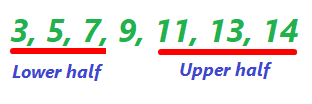To calculate result you have to disable your ad blocker first.
Five Number Summary Calculator
Enter the comma separated values in the input box to find the five number summary using 5 number summary calculator.
Table of Contents:
5 Number Summary Calculator
Five number summary calculator is an online tool that calculates the five-number summary of the given numbers, which includes:
- Minimum Number
- Maximum Number
- First Quartile (Q1)
- Median
- Third Quartile (Q3)
Along with 5 number summary, it also finds:
- Inter Quartile
- Ascending Order
- Descending Order
Definitions:
Inter Quartile:
The difference between Q1 (1st quartile) and Q3 (3rd quartile) is called inter-quartile.
1st Quartile:
1st quartile is also known as the lower quartile, The lower quartile is a range/value in which 25% of points can be found (when they are arranged in ascending order)
Ascending order:
Arrangement of numbers from the smallest to greatest number
Descending order:
Arrangement of numbers from the greatest number to the smallest number
How to find the five number summary?
To find the 5 number summary, follow the below example.
Example:
Find the five-number summary of the given numbers.
7, 9, 14, 3, 5, 11, 13
Step 1: Arrange the data in ascending order.
3, 5, 7, 9, 11, 13, 14
Step 2: Find the minimum and maximum number.
Minimum number = 3
Maximum number = 14
Step 3: Find the median.

Median = 9
Step 4: Find the quartiles (Q1 and Q2).

Q1 = median of lower half = 5
Q3 = median of upper half = 13
Step 5: Write all values to form a summary.
Minimum number = 3
Maximum number = 14
Median = 9
Q1 = 5
Q3 = 13
FAQs
How to calculate the five number summary?
Here's a step-by-step guide to calculate the five number summary:
- Sort the Data in Ascending Order: Arrange the data from least to greatest
- Find the Minimum: First value of the arranged data
- Find the Median (Q2): The middle value of the data set.
- Find the First Quartile (Q1): Q1 splits off the lowest 25% of data from the rest.
- Find the Third Quartile (Q3): Q3 splits off the lowest 75% of data from the rest.
- Find the Maximum: The last value of the arranged data
Example:
Find the five number summary of the given data set: 13, 11, 16, 8, 3, 15, and 10.
Solution
- Arrange the Data in Ascending Order = 3, 8, 10, 11, 13, 15, 16
- Find the Minimum = 3
- Find the First Quartile (Q1) = 8
- Find the Median (Q2) = 11
- Find the Third Quartile (Q3) = 15
- Find the Maximum = 16
Therefore, the 5 number summary is 3, 8, 11, 15, 16.
How do you find Q1 and Q3?
Q1 (the first quartile) and Q3 (the third quartile) are measures of position that divide a data set into four equal parts. Here's how to determine them:
Determine Q1:
- If the first half of the arranged data set has an odd number, then the middle number will be the 1st quartile.
- If the first half of the arranged data set has an even number, Then the average of the two middle numbers will be the 1st quartile.
- Another way to determine Q1 is through the approximation method, especially when dealing with large data sets:
5NumberSummaryCalculator_62
Position for Q1: Position of Q1 = (n + 1)/4
Determine Q3:
- If the second half of the arranged data set has an odd number, then the middle number will be the 3rd quartile.
- If the second half of the arranged data set has an even number, Then the average of the two middle numbers will be the 3rd quartile.
- Another way to determine Q3 is through the approximation method, especially when dealing with large data sets:
Position for Q3: Position of Q3 = 3(n + 1)/4
What is the interquartile range?
The interquartile range (IQR) measures the spread of the middle 50% of the data. It is calculated by subtracting the first quartile (Q1) from the third quartile (Q3):
IQR = Q3 − Q1

